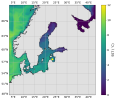I am doing a high-resolution ocean-ice simulation forced by atmospheric reanalysis. The ocean model has the submesoscale parameterization turned on.
resolution: TL319_t13
compset: 2000_DATM%JRA_SLND_CICE_POP2_DROF%JRA_SGLC_SWAV
cesmtag: cesm2.1.4-rc.08
Problem: I am trying out different values for one of the parameters in the submesoscale parameterization. For one setting, I have managed to run the model for > 50 years but it is blowing up after 15 years for a different setting. The error message I get is "vertical thermo error".
Steps taken: I consulted the FAQ for this exact error and am in step 1 of the suggested list of things to do, i.e., see if everything going into the ice model is okay. I am attaching a couple of plots, one showing the SST and identifying the exact location (yellow dot) where the error is occurring. The second plot shows timeseries of various quantities at this location over the last 10 years of the simulation, right until the moment the model blows up. The quantities shown are: (i) SHF (surface heat flux); (ii) SST; (iii) UVEL at the topmost level; and (iv) SUBM_ADV_TEND_TEMP at the topmost level, which is the submesoscale contribution to the temperature tendency. The timeseries do not seem to show anything out of the ordinary for the parameter setting which causes the model to blow up.
Because I am not very familiar with the ice model, my question is do I need to check more quantities before progressing to the next steps given in the FAQ.
Thanks for any help.
resolution: TL319_t13
compset: 2000_DATM%JRA_SLND_CICE_POP2_DROF%JRA_SGLC_SWAV
cesmtag: cesm2.1.4-rc.08
Problem: I am trying out different values for one of the parameters in the submesoscale parameterization. For one setting, I have managed to run the model for > 50 years but it is blowing up after 15 years for a different setting. The error message I get is "vertical thermo error".
Steps taken: I consulted the FAQ for this exact error and am in step 1 of the suggested list of things to do, i.e., see if everything going into the ice model is okay. I am attaching a couple of plots, one showing the SST and identifying the exact location (yellow dot) where the error is occurring. The second plot shows timeseries of various quantities at this location over the last 10 years of the simulation, right until the moment the model blows up. The quantities shown are: (i) SHF (surface heat flux); (ii) SST; (iii) UVEL at the topmost level; and (iv) SUBM_ADV_TEND_TEMP at the topmost level, which is the submesoscale contribution to the temperature tendency. The timeseries do not seem to show anything out of the ordinary for the parameter setting which causes the model to blow up.
Because I am not very familiar with the ice model, my question is do I need to check more quantities before progressing to the next steps given in the FAQ.
Thanks for any help.




